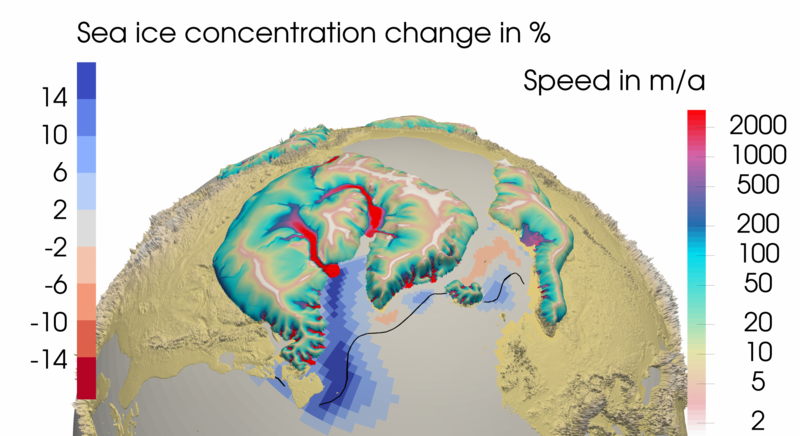Freshwater release and elevation loss affect climate during Heinrich events
During the last ice age, massive iceberg armadas episodically crossed the Atlantic from Canada to Spain. These events are called Heinrich events and play an important role for climate variability during ice ages. They were caused by an instability of the Laurentide Ice Sheet. This ice sheet covered present-day Canada with about four kilometers of ice. Six times during the last 100,000 years, it became unstable. Then, a gigantic ice mass slid into the Atlantic. When the ice reached the ocean, it formed icebergs in the Hudson Strait area. They melted as they sailed across the north Atlantic towards Spain. The authors found that the dramatic climate changes during these events consisted of two phases. First, the meridional ocean circulation weakened, causing cooling in Europe. Then colder winds prolonged this cooling.
The melting of the ice in the ocean released freshwater that has a lower density than ocean water. The less dense water formed a fresh lid on the ocean and thus weakened the sinking of dense water masses in the North that drives the meridional overturning circulation. This weakening reduced the northward heat transport in the Atlantic and thus led to cooling in Europe. The sliding of the ice into the ocean also lowered the surface of the ice sheet. The lower surface allowed the winds to pass further and further northward and thus prolong the cooling in Europe.
This study became possible through the development of a fully coupled ice sheet - climate model. These models are very new and rarely used for such long simulations. Traditionally, studies of the effect of freshwater on the ocean use models without ice sheets, and neglect the ice sheet elevation changes. A previous coupled study (Roberts et al., 2014) that showed the importance of the elevation changes suppressed a major part of the ocean response to the ice discharge by not giving the ocean enough time to respond. Here, for the first time, both the effects on the atmosphere and on the ocean were represented adequately in one simulation, allowing the study of the sequence of the climatic effects.

Original Publication
Ziemen, F., Kapsch, M.-L., Klockmann, M., & Mikolajewicz, U. (2019). Heinrich events show two-stage climate response in transient glacial simulations. Climate of the Past, 15, 153-168. doi:10.5194/cp-15-153-2019.
More information
Roberts, W. H., Valdes, P. J., and Payne, A. J. (2014). Topography's crucial role in Heinrich Events, Proc Natl Acad Sci U S A, 111, 16688-16693, doi:10.1073/pnas.1414882111.
Contact
Dr. Florian Ziemen
Max Planck Institute for Meteorology
Phone: +49 (0) 40 41173 136
Email: florian.ziemen@mpimet.mpg.de
Uwe Mikolajewicz
Max Planck Institute for Meteorology
Phone: +49 (0) 40 41173 243
Email: uwe.mikolajewicz@mpimet.mpg.de
